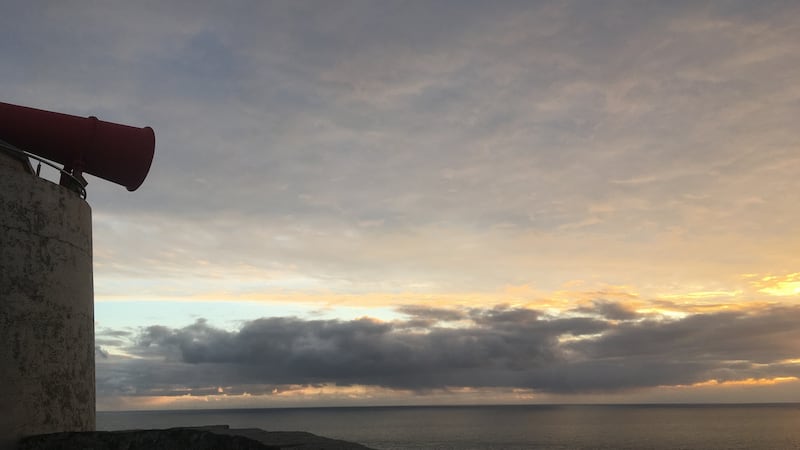On January 11th, 2011, during the most severe winter on record that registered a staggering low of -17.5°C in Mayo, the Commissioners of Irish Lights and harbour authorities nationwide decommissioned all foghorns along the Irish coast. This included a prominent foghorn at Dún Laoghaire harbour’s east pier, which makes a memorable cameo appearance in Hugo Hamilton’s remarkable memoir, The Speckled People.
In recent years, there have been a number of outstanding books published about maritime history and heritage, namely Seashaken Houses: A Lighthouse History from Eddystone to Fastnet by Tom Nancollas, and Adam Nicolson’s Wainwright Prize-winning The Seabird’s Cry: The Lives and Loves of Puffins, Gannets and Other Ocean Voyagers. Jennifer Lucy Allan adds to these titles with a transcendent work of creative nonfiction entitled The Foghorn’s Lament: The Disappearing Music of the Coast, which explores the storied past of these mysterious navigational aids that were silenced a decade ago.
A graduate of Sheffield University and University of London, Allan co-presents Late Junction on BBC Radio 3, pens a monthly column for The Quietus, and contributes to the Guardian. She also served as online editor for The Wire and founded an archival record label called Arc Light Editions, which has released and reissued music by the late Arthur Russell, among many others.
Compelling simplicity
Music and musicology kindled her interest in foghorns, specifically an album called Audience of One by Oren Ambarchi, an Australian percussionist and composer. The Foghorn’s Lament references many other immersive musical experiences, such as John Cage, dub, doom metal, hardcore punk, bone-rattling soundsystems of all shapes and sounds, and unsettling live performances by experimental metal exponents Sunn O))).

“I love the compelling simplicity of drones and massive amounts of fog,” she says. “It’s music, but it’s also a live environment. I’m fascinated by what this does to our sensory experience of music by radically changing the conditions in which we hear it. There is something comparable in what Sunn O))) does live to a foghorn. How it feels and looks keeps changing all the time.”
Perhaps the Dún Laoghaire foghorn had an unconscious role in shaping the musical development of Kevin Shields and Colm Ó Ciosóig, who both grew up in the borough, before founding dream pop pioneers My Bloody Valentine.
In interrogating what is a foghorn and what it sounds like, Allan claims she stopped being a music journalist and became “a foghorn obsessive, a historian of sound, and the favourite anecdote of many friends (‘a book about foghorns...?’)”.
Indeed, there are several hilarious moments in the book when Allan recalls the bemused reaction of librarians and archivists.
“I was coming into their libraries in some cases for a week, for others a month,” Allan reveals. “I adore archives. I think everyone should have a project where they use an archive because it can be so much fun. Archivists acted as a fascinating foil. I’d come in telling them I’m researching foghorns, when most people are there to do genealogy, or find out about their great-great-grandparents, or whether they are connected to royalty, so someone coming in probing foghorns gives them an anecdote to tell at the end of the day. I certainly didn’t expect it to get to the point that it is at now on an imprint like White Rabbit with an editor like Lee (Brackstone).”
White Rabbit is a new publisher, launched by veteran Faber & Faber editor Lee Brackstone in 2020 and dedicated to publishing the most innovative voices in music and literature. Their roster of authors includes David Keenan, Mark Lanegan, Carl Cox, Bobby Gillespie, and former world snooker champion turned prog and electronica DJ, Steve Davis.
“When I started this, I was looking for a break from journalism for a little bit,” she says. “I’d almost burnt myself out. Somebody told me about funding for unusual arts and humanities research projects, such as medieval pregnancy testing, so I applied. I was in a sound research section in an arts and humanities department where you could do first-person writing without anyone batting an eyelid.”

Allan soon discovered an appetite for long-form writing. “I hadn’t worked out that I’d like it to become a book because I didn’t know if I’d like long-form writing,” she says. “I discovered through doing a PhD that I did. A lot of people struggle with a PhD, but I loved it. Previously, the longest length I’d ever had written for publication would’ve been about a few thousand words. Now, I love long-form writing and chasing all these questions, trying to find the answers, but also probing the dead ends. I probably could write another book and really enjoy it, rather than it being something I never want to do again.”
Ecstatic reception
The reception to The Foghorn’s Lament so far has been ecstatic. Icons and luminaries like Brian Eno, Laurie Anderson, Jeremy Deller, Cosey Fanni Tutti and Vashti Bunyan have all been singing its praises. Anderson goes as far to declare: “This has become one of my favourite books.”
“The reaction to the book to date has all gone far beyond my wildest dreams,” Allan enthuses. “It’s blown my mind and left me speechless, particularly Laurie Anderson. All these people are massive cultural figures, so it’s like a supergroup on the back of the book, which is partly because of White Rabbit and Lee’s ability to galvanise people and build a community of readers. Laurie Anderson absolutely blows my mind and she is someone I’ve grown up with as a hero. On publication day, I’m going to pop open a bottle of fizzy and read out the Laurie Anderson quote. Then, I can happily retire.”
A sense of community is central to The Foghorn’s Lament. “It’s very important in both music and the book world,” Allan says. “Communities sustain the existence of these media, especially when you’re writing about foghorns and avant-garde music. The research took many manifestations over the years. One of my favourite aspects about doing this book was listening to people who were moved to tell me all about their experiences from all over the world. I became completely consumed by foghorns. People sent me all manner of links and recordings.”
Obviously, not everyone would share Allan’s interest. “While I love a lot of the music I cover, other people really hate it, and it’s very similar with foghorns,” she adds. “Discovering people’s grievances and complaints was a total turning point in the research and writing and a really joyful one. There’s something hilarious about people complaining. The whole drama and pettiness of it all, and just how strenuously people give out about their environment and say how it should be different.
“Hunting for these noise complaints became one of my favourite parts of the whole project. I loved some of the letters that I discovered from 100 or 150 years ago. They are emotional letters. When people get emotional, their language and tone changes. It proves just how much this unique sound has embedded itself in people’s minds, which is at the heart of this book. Ultimately, this is still somewhat impenetrable.”
The Foghorn's Lament: The Disappearing Music of the Coast is out from tomorrow on White Rabbit.










